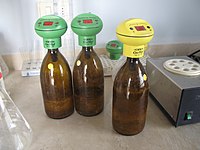
Photo from wikipedia
Abstract In this study, a new tool for better estimation of CO 2 dissolution in aquifers is proposed. It will be shown that this model could increase the accuracy of… Click to show full abstract
Abstract In this study, a new tool for better estimation of CO 2 dissolution in aquifers is proposed. It will be shown that this model could increase the accuracy of the prediction considerably by involving all the effective parameters and their interaction through the design of experiments approach (response surface based on Box-Behnken method). It is also shown that the difference among previous proposed dimensionless models may be the result of the difference in the amount of dissolved CO 2 for a fixed value of the Rayleigh number. In other words, for different values of the Rayleigh number (the result of changes in different parameters), the same amount of CO 2 dissolution observed, but this would not be apparent in these models. Another contribution of this work is summarizing the parameters involved by using appropriate thermodynamic correlations (pressure, temperature, salinity, porosity and permeability are all required factors). In addition, the dependency of fluid parameters on each other is considered during the study, through the thermodynamic correlations, and the effects of different parameters are studied simultaneously. The results indicate that salinity is the most important parameter in all the periods, while permeability is the most controlling parameter, after salinity, in the overall behaviour of the system. For all the periods, porosity and salinity have negative effects, while temperature and permeability have a positive influence. Although pressure has small negative impact on the diffusion coefficient and amount of dissolved CO 2 in the early period, it affects thermodynamic correlations (especially density difference between brine and brine + CO 2 solution), and its impact changes from negative to positive through the life-time of the sequestration. Since, simulations are performed at discrete points of a continuous range of parameters in the development of the proxy models, Monte Carlo simulation was used to explore the whole range for the final conclusion. The closely similar behaviour of the Monte Carlo result curve and discrete points result, shows that the proxy models can be freely used in the selected ranges.
Journal Title: International Journal of Greenhouse Gas Control
Year Published: 2017
Link to full text (if available)
Share on Social Media: Sign Up to like & get
recommendations!